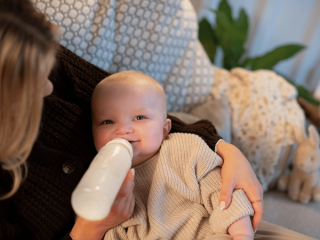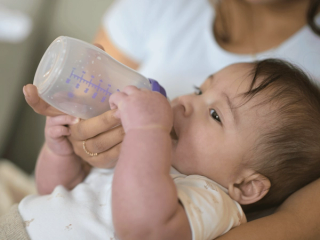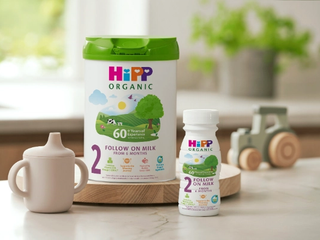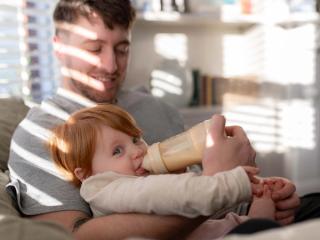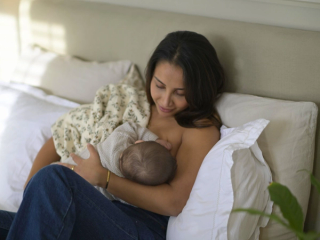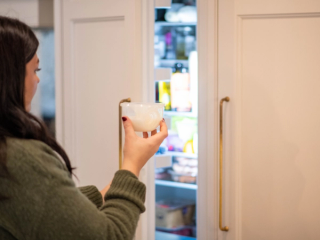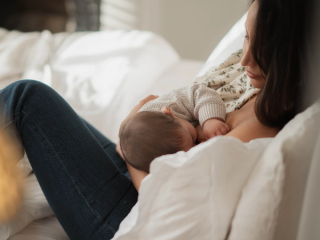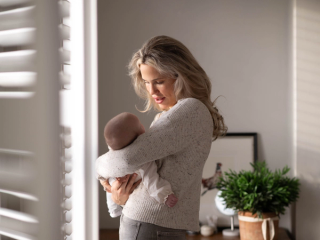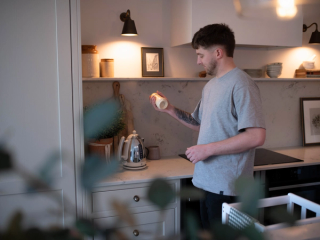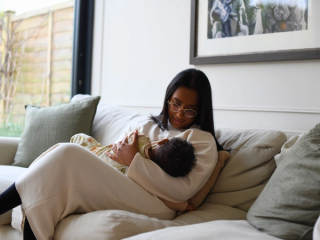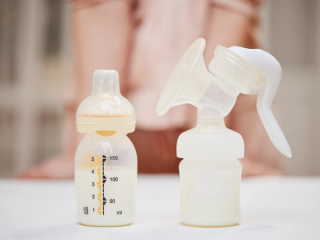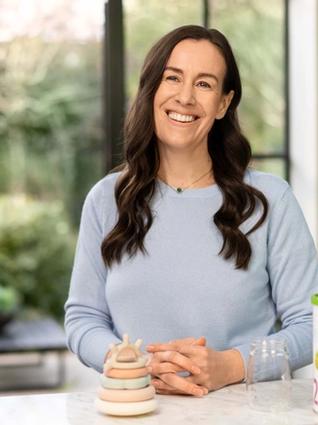
- Home
- Advice Hub
- Baby
- Baby Feeding
- How To Make Up A Bottle Feed
How to Prepare Formula Milk: A Step-by-Step Guide
Read our guide step-by-step guide on what how to prepare formula milk for your baby.
How to Make a Bottle of Formula Milk
Can I reheat formula milk?
Can I prepare bottles of formula in advance?
How long does a prepared bottle of formula last?
How to prepare formula milk quickly
Can I use bottled water?
Can I store prepared baby and toddler formula in the fridge?
Can I freeze formula?
What’s the ratio for preparing a bottle of formula?
Your first time preparing formula milk can feel a bit daunting – especially if your little one is waiting with increasing impatience. This simple guide will show you how to make up a formula bottle, from ensuring you are achieving the perfect temperature to keeping everything clean and safe – and don’t worry, once you’ve done it a few times it will become second nature.
For advice on which formula milk is best for your baby, check out our guide to choosing and changing formula milks and see our parental advice page, where real parents share their experiences.
How to Make a Bottle of Formula Milk
Before you get started, familiarise yourself with the back of pack instructions as some formula milks may differ slightly in how they need to be prepared.
You will need:
- A kettle
- Sterilised bottle or beakers with teats and lids
- Formula milk suited to your baby's age
Boil fresh tap water
Boil 1 litre of freshly-run tap water and leave to cool for no longer than 30 minutes.
The water that goes into your baby’s formula milk should be fresh – so not water that’s been sitting in the kettle for hours. Also avoid using artificially softened water.
Wash your hands
It’s very important to keep everything as clean as possible, so while the water is cooling, wash your hands and clean and disinfect the bottle preparation area. Make sure your bottle, teat and lid are also clean and have been sterilised.
Measure the right amount of water
Measure the required amount of cooled boiled water into a sterilised bottle, following the feeding guide on the pack. Always pour the water in first so you can use the measuring gauge on the bottle. Below is a rough guide to how much you can expect your baby to drink.
Add the right amount of formula powder
Using the scoop provided, add the required number of scoops of powder – one level scoop of powder for each fluid ounce of water (approx. 30 ml). For example, 5 scoops in 150 ml.cooled boiled water. Level off the powder with the back of a clean dry knife, but don't press the powder down into the scoop. All formula milks have instructions on the packaging to remind you of the correct ratio.
Shake the bottle well
Place the sterilised teat and cap on the bottle and shake well until all the powder has dissolved (approx. 15 seconds).
Cool the milk to the right temperature
Cool the milk to drinking temperature (approximately 37°C) by holding the bottle under cold running water or by placing in a bowl of cold water. ALWAYS test the temperature of the milk before feeding by dripping a bit onto the inside of your wrist; the milk should feel warm, not hot.
For more advice, check out our guide on how to bottle feed your baby.
Can I reheat formula milk?
Sometimes your little one won’t finish their bottle and you might wonder if you can reheat it later for the next feed. The answer is no. It is not recommended to reheat formula milk. Each feed should be made fresh and used immediately. Any formula milk left over after a feed should be discarded. This is because once your baby has started drinking from the bottle, the bacteria from their saliva mixes with the milk in the bottle.
If a bottle hasn’t been started and its been kept at room temperature, its safe to use for up to 2 hours.
Can I prepare bottles of formula in advance?
It’s always best to make up formula as and when you need it, but sometimes you might need to make a bottle in advance. The following advice is for when it’s really necessary, for example when you are not able to take a vacuum flask filled with boiled fresh tap water to make up a feed when you’re out and about, and when to ready to feed formula isn’t an option. We don’t recommend stocking your fridge with premade bottles of formula on a regular basis.
Make up the formula as normal, then store it in the back of the fridge (where it’s coldest) at 5°C or below. Premade formula must be used within 24 hours even when refrigerated. If you’re taking pre-prepared formula out and about, use an ice pack to keep it cool and use within 4 hours. If formula is left at room temperature, it should be consumed within 2 hours.
If your baby has started a bottle and not finished it, these rules don’t apply – leftover formula should always be thrown away.
The advice on using formula feeds outside of the home differs in Ireland – please refer to the HSE website for further information: Bottle feeds when you're away from home .
How long does a prepared bottle of formula last?
If your little one falls asleep while you’re preparing their milk, or you get sidetracked between making and feeding by a nappy explosion (it happens!), that bottle of formula milk should be ok to drink for up to 2 hours if left at room temperature. If a bottle is started and abandoned, however, it should be discarded. Check out all our formula milk FAQs for more guidance.
How to prepare formula milk quickly
Boiling a kettle, then waiting for it to cool, then mixing a feed, while also ensuring everything you need is clean, sterile and ready to use can make preparing formula feel like a long old job – especially if your little one is hungry. One of the best ways to reduce the time taken is to try and stay on top of sterilising and cleaning bottles so that you always have a bottle, teat and cap ready to go. Other than that, sadly there are no shortcuts with powdered formula. The water must be boiled and cooled to ensure the formula is safe for your baby to drink. Unless you’re prepared to invest in a boiling water tap or special formula preparation machine, you just have to chalk this up to one of the many challenges of parenting.
Can I use bottled water?
Yes, you can use bottled water to make up a feed – but it will still need to be boiled, so it’s only worth doing if you’re in a country where you’re not sure about the quality of the tap water. Some bottled water has higher levels of sodium and sulphate than is good for your baby, so check the packaging and make sure the levels are within safe limits: less than 200 mg per litre of sodium (‘Na’), and less than 250mg per litre of sulphate (‘SO’ or ‘SO4’).
Can I store prepared baby and toddler formula in the fridge?
If circumstances require you to make formula milk in advance, you should store it in the coldest part of the fridge and consume within 24 hours. Remember to warm it to the right temperature by placing in a bowl of boiled water before you give it to your baby.
Can I freeze formula?
No, it is not safe to freeze formula milk. It is always best to make formula milk up as and when you need it.
What’s the ratio for preparing a bottle of formula?
The ratio of formula milk powder to water is usually one level scoop to one fluid ounce (approximately 30 ml) of water; always refer to product packaging for preparation guidelines.. Your formula package will include a scoop that measures the perfect amount of powder, so make sure you keep the scoop. Your bottles will show volume measures on the side so you can get the water quantity just right.
Conclusion
We hope this step-by-step guide to preparing a bottle of formula milk has been helpful. The most important thing to remember is to follow the instructions on your formula milk packaging.
Important Notice
We recognise that breastfeeding is best, providing many benefits to both mothers and infants. We also recognise that every parenting journey is unique, and we are here to support you through this journey, however you choose to feed your baby.
If you choose to breastfeed it is important that you eat a healthy well-balanced diet in preparation for and during breastfeeding. Before deciding to combination or formula feed your baby, note that reducing or stopping breastfeeding can be difficult to reverse. Babies feed on demand, so replacing breastfeeding with infant formula milk may reduce your supply. Formula feeding has both social and financial implications. Talk to your midwife or health visitor for guidance and support.
If you choose to use formula milk, make sure you choose the right milk for your baby’s age and prepare and store it according to the instructions on the packaging. Not doing so may make your baby ill. Infant formula is a nutritionally complete breastmilk substitute that can be used from birth. From 6 months you can choose to use follow on milk as part of a mixed diet and from 12 months you have the option to move onto growing up milk alongside a balanced diet.
